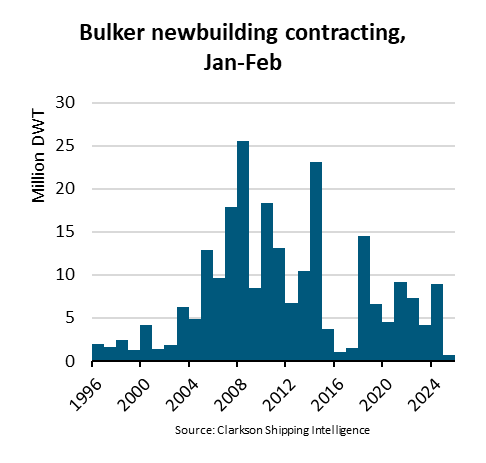
Fleet news
For the oil product tanker fleet, our forecast is steady from early August with tankers being delivered as predicted and just eight MR orders, by unknown owners, having been placed at a South Korean shipyard since then. We also keep our demolition forecast intact, resulting in an estimated fleet growth of 2.4% – the lowest level since 2012. More importantly, our 2019 fleet growth forecast remains fixed at 2.4%, with deliveries and demolitions both falling.
It is not only orders for oil product tankers that South Korean shipyards have been able to sign with owners/investors. Thanks to government support, they have landed 44.5% of all orders in 2018 to date, measured by Compensated Gross Tonnage (CGT); this is up from just 27.6% for the whole of 2017. The order book has been filled with classic South Korean ‘trademarks’ of large and complex ship types, including Very Large Gas Carriers and Ultra Large Containerships.
For crude oil tankers, the recent upswing in earnings caused fleet growth to rise earlier than expected. Demolition expectations are unchanged, but the pace of delivery is slowly going up. BIMCO expects the crude oil tanker fleet to increase by 0.9% in 2018. Looking into 2019, much depends on the level of demolition.
Following three low months of ordering activity from June to August, September saw owners and investors showing a renewed interest in crude oil tanker tonnage. The combined order for 1.7m DWT of Suezmax (5) and Aframax (8) was the highest since June 2017.
For the 12 months ending 1 November 2018, fleet growth was pretty much flat: 0% for the VLCC sector’, -0.2% for the Aframaxes, and +0.4% for the total crude oil tanker fleet.Among the oil product sectors, the fleet of LR2s has increased by 4.5%, LR1s by 2.5% and the MR/Handy sector by just 1% – a total of 2.2% for the oil products tanker fleet.
BIMCO members can find easy-to-use graphics on fleet development for all shipping sectors, including oil tankers, here.
Outlook
Can we expect a normal winter market for tankers where rates go up as demand for shipping increases? What we saw in October was positive, but there is likely to be volatility this winter as geopolitical issues have been piling up. However, we expect some positive seasonality to return, after last year’s absence.
The US has granted ‘waivers’ to its sanctions against Iran to eight countries including, Japan, India, Italy and South Korea, all of which are among the top 10 buyers of US crude oil. Initially, the impact will be that oil exports out of Iran will continue. In the medium term, it will matter how much oil imports are waived and whether it is a fixed volume, or one that must be gradually reduced.
A large proportion of Iranian exports go to Asia – two-thirds to India and China alone.
On top of the already low visibility into the demand for oil and, subsequently, tankers, we see changing trade lanes caused by the US sanctions on Iran. A shift away from Iran primarily to other Middle Eastern exporters doesn’t change trading patterns much, as barrels will be switched with heavy sour crude oil of a similar quality.
Elsewhere in the world, Libya is scaling up production and the US has set a record for crude oil exports to all nations other than China for seven months in a row.
The International Energy Agency (IEA) has revised its estimates for global oil demand down for both 2018 and 2019. This is because of trade concerns, weaker economic outlook, higher prices and a revision of data. Despite that, Q4-2018 is expected to deliver the first quarterly oil demand exceeding 100m barrels per day (bpd) at 100.2m bpd.
For 2018, the IEA expects the OECD to increase its oil demand by 0.3m bpd and non-OECD by 1m bpd (out of which China takes 0.5m bpd and ‘other Asia’ 0.4m bpd). For 2019, the IEA expects the OECD to raise oil demand by 0.1m bpd and non-OECD by 1.3m bpd (China and ‘other Asia’ to expand by the same rate as in 2018).
The price of crude oil has gradually slipped during October; a development signalling that supply is again running ahead of demand. Both the IEA and the US Energy Information Administration (EIA) estimate that global oil inventories will build in both Q4-2018 and H1-2019.
Source:BIMCO
Please Contact Us at:
admin@xindemarine.com



 Ningbo Containerized Freight Index Weekly Commentar
Ningbo Containerized Freight Index Weekly Commentar  Ningbo Containerized Freight Index Weekly Commentar
Ningbo Containerized Freight Index Weekly Commentar  Ningbo Containerized Freight Index Weekly Commentar
Ningbo Containerized Freight Index Weekly Commentar  BIMCO Shipping Number of the Week: Bulker newbuildi
BIMCO Shipping Number of the Week: Bulker newbuildi  Ningbo Containerized Freight Index Weekly Commentar
Ningbo Containerized Freight Index Weekly Commentar  Ningbo Containerized Freight Index Weekly Commentar
Ningbo Containerized Freight Index Weekly Commentar